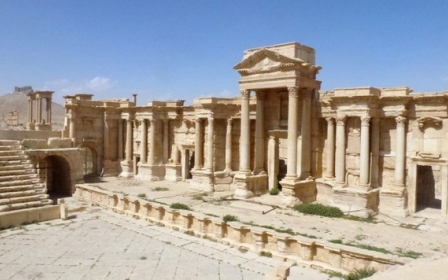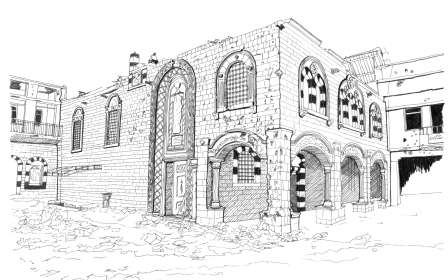In pictures: One Syrian’s attempt to preserve the memory of Palmyra
After members of the Islamic State (IS) group captured the Syrian city of Palmyra from the Syrian army in 2015, they uprooted more than just the area’s historic Roman ruins. Thousands fled to the relative safety of rebel-held areas of Aleppo. Among them was Ali Saleh al-Taha, 58, who took refuge in the city of al-Bab in the district of Aleppo. There he set about recreating the ruins of Palmyra in his own way. (All photographs: MEE/Ali Haj Suleiman)
Before the arrival of IS fighters in Palmyra, Taha had spent 25 years working on the excavation of archaeological sites. His father and grandfather before him also worked on the ruins, regularly collaborating with foreign archaeologists. His own experiences and the legacy passed down through his relatives have given him a near-perfect idea of what the destroyed 2,000-year-old heritage site looked like, right down to the smallest detail.
Taha uses memory and publicly available photographs to recreate the ruins of Palmyra using plaster, operating out of a workshop he rents in al-Bab. The models he builds are scaled replicas of the original buildings in Palmyra. Taha’s recreation of the Temple of Baal is two metres by two and 40cm high.
Palmyra was established 4,000 years ago near a desert oasis and quickly developed into a significant trading post, connecting the Levant and Mesopotamia regions. With the rise of the Roman Empire, control of the city frequently changed hands between the Romans and Persians, resulting in the damage and destruction of a number of its structures - although some were later rebuilt and restored. The city remained relatively untouched throughout the Islamic period and significant attempts to restore the ruins began in the 1960s. IS fighters destroyed some major structures shortly after they captured the city in May 2015 and again during their retreat in 2016.
A reconstruction of the Temple of Baal in Palmyra. The structure was built in 17AD and expanded by the Roman Emperor Hadrian a little over a century later. Baal was an ancient Semitic term used to refer to several different deities, worshipped by a number of historically separated peoples in the Near East. The Canaanites, for example, held their incarnation of Baal to be one of the most important gods in their pantheon, but in the Hebrew Bible, Baal refers to several gods held to be false by the Israelites.
Soon after IS started destroying Palmyra’s ancient heritage, archaeologists began looking at ways to use 3D capture technology to recreate the structures. Restoration specialists have used old photographs of the site to create 3D printed images of the ruins.
Taha lost four children during the escape from Palmyra and now lives with his wife and surviving son, who is 20. He also suffered debilitating injuries himself, and now suffers from chronic back pain and other ailments, which make his task more challenging.
The native of Palmyra is driven by a compulsion to educate future generations about the historic sites that were lost. He says that he hopes “the children of Palmyra do not forget the ruins, civilisation and heritage of their city”.
This article is available in French on Middle East Eye French edition.
Middle East Eye propose une couverture et une analyse indépendantes et incomparables du Moyen-Orient, de l’Afrique du Nord et d’autres régions du monde. Pour en savoir plus sur la reprise de ce contenu et les frais qui s’appliquent, veuillez remplir ce formulaire [en anglais]. Pour en savoir plus sur MEE, cliquez ici [en anglais].




